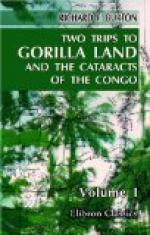It is still a disputed point whether the weight is supported by the knuckles of the forehand, like the chimpanzee, or whether the palm is the proper fulcrum. M. du Chaillu says ("First Expedition,” chap, xx.), “the fingers are only lightly marked on the ground;” yet a few pages afterwards we are told, “The most usual mode of progression of the animal is on all-fours and resting on the knuckles.” In the “Second Expedition” (chap, ii.) we read, “The tracks of the feet never showed the marks of toes, only the heels, and the track of the hands showed simply the impressions of the knuckles.”
The attack of the gorilla is that of the apes and the monkeys generally. The big-bellied satyr advances to the assault as it travels, shuffling on all-fours; “rocking” not traversing; bristling the crest, chattering, mowing and displaying the fearful teeth and tusks. Like all the Simiads, this Troglodyte sways the body to and fro, and springs from side to side for the purpose of avoiding the weapon. At times Quasimodo raises himself slightly upon the dwarfed “asthenogenic,” and almost deformed hind limbs, which look those of a child terminating the body of a Dan Lambert: the same action may be seen in its congeners great and small. The wild huntsmen almost cried with laughter when they saw the sketches in the “Gorilla Book,"[FN#24] the mighty pugilist standing stiff and upright as the late Mr. Benjamin Caunt, “beating the breast with huge fists till it sounded like an immense bass drum;” and preparing to deal a buffet worthy of Friar Tuck. They asked me if I thought mortal man would ever attempt to face such a thing as that? With respect to drumming with both forehands upon the chest, some asserted that such is the brute’s practice when calling Mrs. Gorilla, or during the excitement of a scuffle; but the accounts of the bushmen differ greatly on this point. In a hand-to-hand struggle it puts forth one of the giant feet, sometimes the hinder, as “Joe Gorilla” was wont to do; and, having once got a hold with its prehensile toes, it bites and worries like any other ape, baboon, or monkey. From this grapple doubtless arose the old native legend about the gorilla drawing travellers up trees and “quietly choking them.” It can have little vitality, as it is easily killed with a bit of stone propelled out of a trade musket by the vilest gunpowder, and the timid bushmen, when failing to shoot it unawares, do not fear to attack it openly. As a rule, the larger the Simiad, the less sprightly it becomes; and those most approaching man are usually the tamest and the most melancholy—perhaps, their spirits are permanently affected by their narrow escape. The elderly male (for anthropoids, like anthropoi, wax fierce and surly with increasing years) will fight, but only from fear, when suddenly startled, or with rage when slightly wounded. Moreover, there must be rogue-gorillas, like rogue-elephants, lions, hippopotami, rhinoceros, and even stags, vieux




